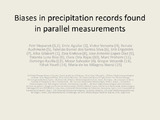Por favor, use este identificador para citar o enlazar este ítem:
http://hdl.handle.net/20.500.11765/11973
Biases in precipitation records found in parallel measurements
| Título : | Biases in precipitation records found in parallel measurements |
| Autor : | Stepanek, Petr; Aguilar, Enric; Venema, Victor K. C.; Auchmann, Renate; Silva, Fabricio Daniel dos Santos; Engström, Erik; Gilabert Gallart, Alba; Kretova, Zoia; López Díaz, José Antonio

 ; Luna Rico, Yolanda
; Luna Rico, Yolanda



 ; Oria Rojas, Clara; Prohom Duran, Marc; Rasilla, Domingo; Salvador, Mozar; Vetacnik, Gregor
; Oria Rojas, Clara; Prohom Duran, Marc; Rasilla, Domingo; Salvador, Mozar; Vetacnik, Gregor |
| Palabras clave : | Precipitation measurements; Climate data; Conventional manual measurements |
| Fecha de publicación : | oct-2015 |
| Citación : | 10th EUMETNET Data Management Workshop (2015) |
| Versión del editor: | https://dx.doi.org/10.25267/10.13140/RG.2.1.4348.6967 |
| Resumen : | In this work we investigate biases introduced by the transition from Conventional to automatic precipitation measurements. This is another study in the framework of The Parallel Observations Scientific Team (POST, http://www.surfacetemperatures.org/databank/parallel_measurements), which is a newly created group of the International Surface Temperature Initiative (ISTI) supported by the World Meteorological Organization (WMO). The goals of POST are the study of climate data inhomogeneities at the daily and sub-daily level. Long instrumental climate records are usually affected by non-climatic changes, due to various reasons like relocations, changes in instrumentation, measurements schemes etc. Such inhomogeneities may distort the climate signal and can influence the assessment of trends and variability. For studying climatic changes it is important to accurately distinguish non-climatic from climatic signals. This can be achieved by studying the differences between two parallel measurements. These need to be sufficiently close together to be well correlated. One important ongoing worldwide transition is the one from manual to automated measurements. We need to study the impact of automated measurements urgently because sooner or later this will affect most of the stations in individual national networks. Similar to temperature series, we study the transition from conventional manual measurements (CON) to Automatic Weather Stations (AWS), using several parallel datasets distributed over Europe and America. The ratio series AWS-CON are subject to quality control, and before the analysis obvious errors are removed. Further, the series are inspected for internal inhomogeneities and– if necessary –the records are split into two or more homogeneous segments. Finally, each segment is studied to understand the biases introduced by the transition, its seasonality as well as changes in the empirical distributions. When additional variables are available, an attempt is made to study the effects of other variables on the observed biases. |
| Descripción : | Presentación realizada en: 10th EUMETNET Data Management Workshop celebrado en St. Gallen, Suiza, del 28 al 30 de octubre de 2015. |
| URI : | http://hdl.handle.net/20.500.11765/11973 |
| Colecciones: | Otras presentaciones-congresos |
Ficheros en este ítem:
| Fichero | Descripción | Tamaño | Formato | ||
|---|---|---|---|---|---|
| 12_Stepanek_Slides_we... | 1,84 MB | Adobe PDF |  Visualizar/Abrir | ||
| Stepanek_Abstract.pdf | 70,87 kB | Adobe PDF |  Visualizar/Abrir |
Los ítems de Arcimis están protegidos por una Licencia Creative Commons, salvo que se indique lo contrario.





